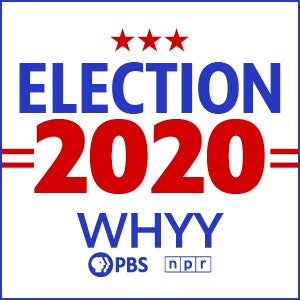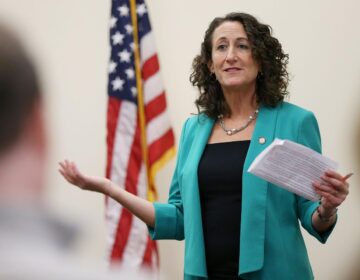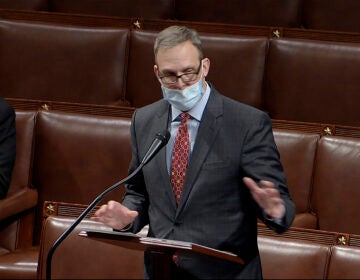Trump’s army of new Pa. voters could shape 2022 elections — if the GOP can keep them
While President-elect Joe Biden’s strength with urban and suburban voters ultimately won him Pa., Trump’s performance cannot be understated, far exceeding his 2016 totals.
Listen 4:58
Protesters outside the office of state Rep. Jeff Wheeland (R-Lycoming) on Nov. 20, demanding immediate action on alleged "election irregularities." (Courtesy of Jeffrey Stroehmann)
Before casting a ballot for President Donald Trump this year, Brenda Baer had never voted. The 53-year-old mom of four just didn’t see a reason.
“I always felt that my life was pretty good,” Baer said as she applied hair spray before a nursing shift at an adolescent psychiatric unit. “I guess I was a little complacent, feeling that I lived in the greatest nation in the world, and nothing would ever change that.”
Baer lives in Port Allegany, a 2,000 person borough tucked into the foothills of the Appalachian Mountains in rural McKean County. Manufacturing plants making Zippo lighters and kitchen cutlery are nearby, and rigs drilling for natural gas dot the landscape. In 2016, 70% of the county’s voters went for Trump.
But Baer said the path to casting her first ballot began after that election, when a longtime friend who is a Democrat said she could no longer be friends with anyone who supported Trump. Baer hadn’t voted for Trump, but she liked him, and that comment bothered her.

Soon Baer started noticing signs of what she saw as Democrats’ intolerance everywhere: people she knew on Facebook calling Trump voters ‘traitors;’ a talking head on CNN suggesting his supporters condoned racism; a relative reacting with joy to the news that the president had contracted COVID-19.
“In the past, I looked at the Democratic party as the ones who were more open-minded…I’ve seen the complete opposite happen in the last four years,” said Baer, whose kids are split politically. “I think it’s more important than ever in history for people to come out and vote.”
While President-elect Joe Biden’s strength with urban and suburban voters ultimately won him Pennsylvania this year, Trump’s performance cannot be understated. His vote total is second only to Biden in the history of Pennsylvania presidential elections. Trump performed substantially better in the state than he did in 2016 — garnering more than 400,000 additional votes.
Those gains came in spades across the state, from deep red pockets like McKean County to a groundswell of new support in Philadelphia.
The question for both parties is whether these trends will hold beyond 2020 — in races where there’s not a Trump at the top of the ticket.
The ‘biggest surprise of election night’
President Trump bet his 2020 campaign in Pennsylvania around squeezing more out of his base of white, rural, non-college voters and peeling off urban voters disaffected with Democrats.
In some ways, that play paid off.
Trump ate into Democratic margins in nearly three-quarters of Pennsylvania’s 67 counties, according to independent political analyst Ben Forstate. And record-setting turnout across the state meant that, even in counties where Biden’s share of the vote surpassed Clinton’s in 2016, Trump still grew his vote total.
“I think that was probably the biggest surprise on election night for a lot of people,” said Jason High, a political consultant who managed Republican Scott Wagner’s unsuccessful 2018 gubernatorial run. “I don’t think most people thought that there were more of these voters available.”
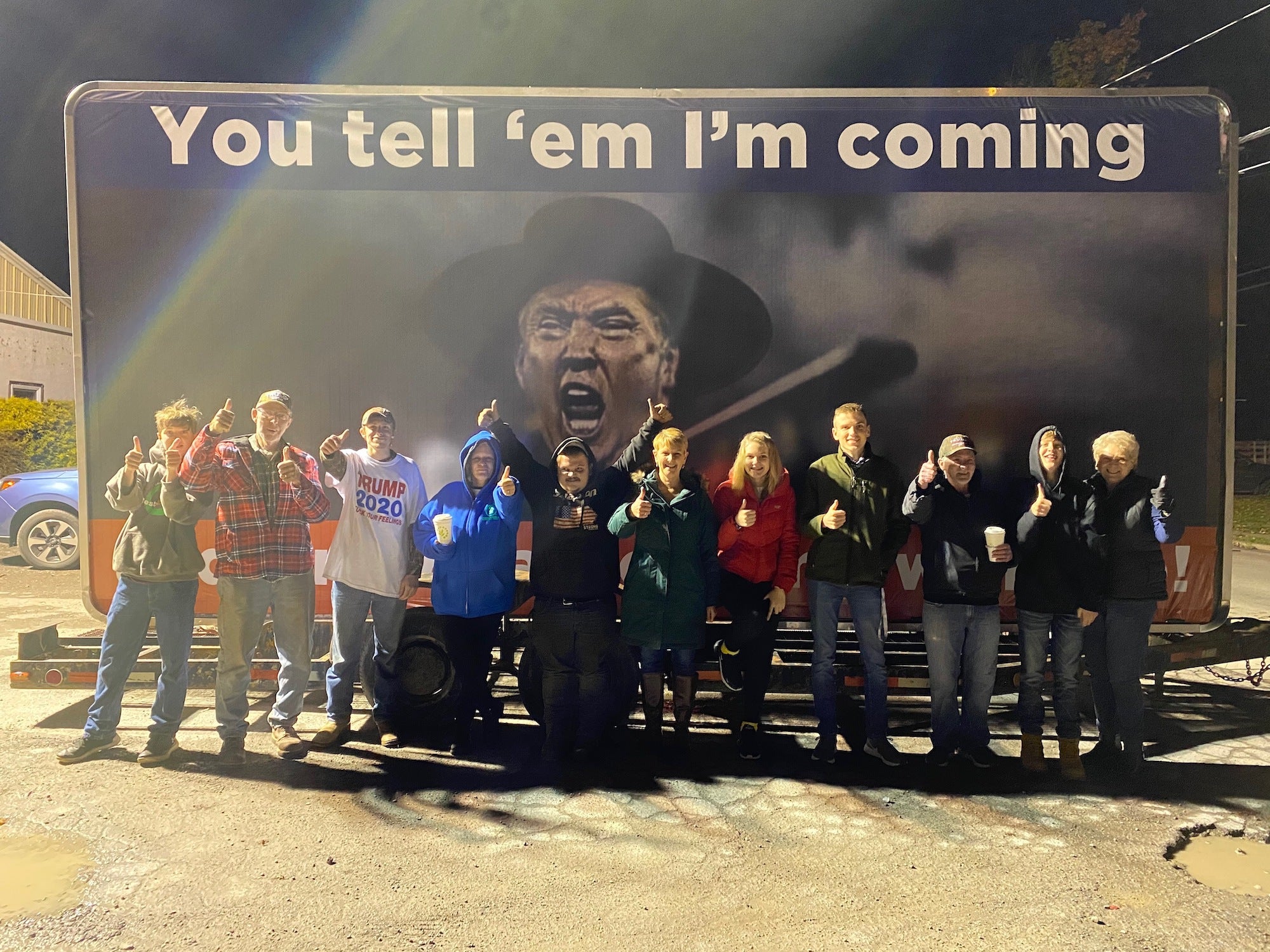
Lycoming County resident Tim Clark, his wife, and his son all cast their first ballots for Trump this year.
The 63-year-old retired truck driver said that in 2016 he “wasn’t tuned in,” but over the last four years, he’s come to appreciate Trump’s economic policies and support for the military.
“He was for the American people. He was for us,” Clark said.
Still, Clark’s biggest motivation to vote in 2020 was his frustration with how he perceives the treatment Trump received from Democrats during his tenure as president. To Clark, the 2019 impeachment inquiry into allegations that Trump sought foreign interference ahead of the 2020 election was more of a black eye on the left than the president.
“All they did was fight him for four years,” Clark said. “They tried to … get him out of there.”

Potter County resident Colette Carlson said she was also motivated to cast her first ballot for Trump by her frustration with Democrats, who she sees as anti-patriotic.
Her late husband is a Marine who died by suicide in 2012 after serving multiple tours in Iraq and suffering a traumatic brain injury.
“To see everything he had to go through for his country and then you are being told to hate it,” said the 35-year-old grocery store clerk. “You can’t be proud to be American these days. That’s not right.”
President Trump’s vote totals in Lycoming and Potter counties grew by 16%. In McKean County, it went up by more than 20%.
Are these new Trump voters here to stay?
Ultimately, voters like Clark and Carlson were not enough for Trump to win Pennsylvania. Biden was able to find new voters in deep red counties, too. Not enough to shift Trump’s dominance there, but enough to hold the line.
“The increases of Trump voters were met by just enough Democrats so that [Biden] could pull out wins in the suburbs,” Forstate said.
Biden wiped out Trump’s gains from counties where his 2016 margins improved with new votes from Allegheny County and Montgomery County alone.
However, if Trump’s new voters become reliable GOP stalwarts, they could prove important in Pennsylvania politics moving forward, including races for the U.S. Senate and governor in 2022. Clark and Carlson both said they plan on continuing to vote for Republican candidates.
Longtime observers like Jason High doubts this new constituency will hold its enthusiasm when Trump is no longer on the top of the ticket.
“I don’t think, in these numbers, those voters are available to generic Republicans,” High said. “Unless the rumors that [Donald Trump Jr.] is going to run for Senate are true, and then I think there is a chance they will turn out for him.”
High speaks from experience. In 2018 his candidate, Scott Wagner, presented himself as akin to the president: He asserted America was being a “nation of victims,” warned of immigrant caravans approaching the southern border, and pitched himself to Philly’s majority voters of color by asking “what do you have to lose?”
The waning days of Wagner’s campaign included a livestreamed rant under a roadside billboard, in which he threatened to “stomp” incumbent Democratic Gov. Tom Wolf’s face with golf spikes, a notion he later described as a poor metaphor.
Wolf, who presents himself as both a down-to-earth Jeep driver and a high-minded liberal, beat Wagner by more than 15 points.
“We ran I would argue probably the most Trump-like candidate you could run in Pennsylvania and [Trump loyal voters] didn’t turn out for us,” High said.
That same rule held true in 2018’s U.S. Senate race when longtime Democratic Sen. Bob Casey easily dispatched a challenge from former congressman and high-profile Trump booster Lou Barletta.
At least in part, those 2018 losses were due to a Democratic surge. It wasn’t just Trump-like Republicans who lost that year — it was the entire party. Democrats nearly swept southeastern state House and Senate districts and, in part thanks to a newly-redrawn congressional map, picked up enough seats to balance Pennsylvania’s D.C. delegation for the first time in years.
Not every cycle will be so good for Democrats.
And so despite their recent bad luck with Trumpish candidates, some Pennsylvania Republicans already seem to be building their 2022 strategy around capturing the president’s voters. Most notably, State Sen. Doug Mastriano (R-Adams), is heavily rumored to be planning to run for governor. Mastriano, a combat veteran with decades of military service, has promoted baseless voter fraud conspiracies and been leading a so-far unsuccessful attempt to nullify Pennsylvania’s vote total and allow the Republican-controlled legislature to appoint electoral college representatives.
The problem with this strategy, High said, is that for a Republican to win statewide office in Pennsylvania they likely also need to win the support of the state’s more moderate, suburban Republicans. That bloc, which helped oust Trump, was crucial in allowing the GOP to keep majorities in the state legislature, hold the line in congressional races and win the state’s row offices for the first time in decades.
“I think they are all trying to devise a strategy [of]…what do I need to do to get through the primary, and how can I still be electable?” High said. “We are in a very polarized environment, and I don’t know how you navigate it.”
Democrat hopefuls face a similar dilemma: Progressive candidates that excite their urban, educated base may turn off the suburban voters that handed Biden his victory this year but voted to keep moderate Republicans like Montco state Rep. Todd Stephens in office.
‘People want answers’
There’s another, more fundamental reason why many of Trump’s 2020 voters may not keep voting — the president has convinced them the electoral process is rigged.
Ever since election night, Trump has asserted without evidence that the election was rife with voter fraud, frequently singling out Pennsylvania.
There is no evidence of widespread fraud in the Keystone state, and state and federal court judges — some of which were appointed by Trump — have rejected virtually all of his campaign’s attempts to reverse the election.
Still, the president’s claims have rung true to many of his supporters in Pennsylvania.
“What I am hearing is: People want answers. Something didn’t seem right on this,” said Jeffrey Stroehmann, a GOP organizer in rural Lycoming County. “I don’t think they are going to be motivated [to keep voting] unless they know the integrity of this election is good.”
McKean County resident Brenda Baer, who cast her first vote for President Trump this year, has watched the election certification process unfold with rising anger, convinced the election was “rigged.”
For now, Baer plans to vote in 2022 and beyond. But she’s already lost her enthusiasm for the electoral process inspired by casting a ballot for Trump a few short weeks ago.
“I would remain skeptical as to whether that vote would really count or mean anything,” she said.
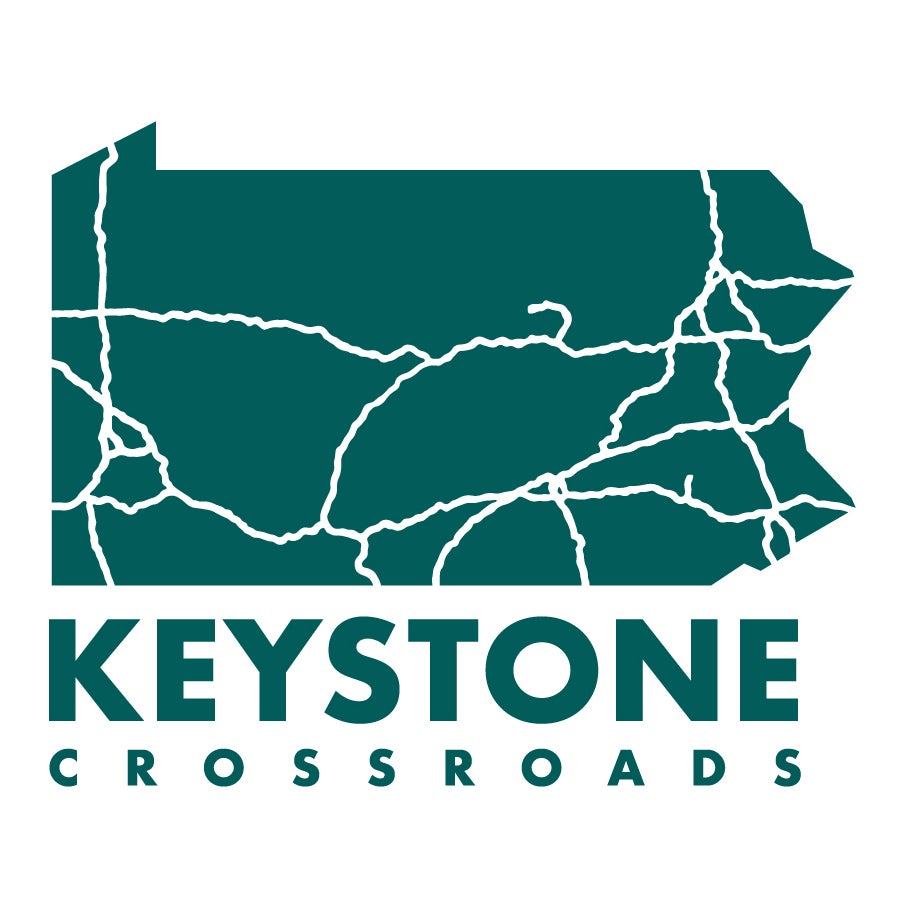
Get more Pennsylvania stories that matter
WHYY is your source for fact-based, in-depth journalism and information. As a nonprofit organization, we rely on financial support from readers like you. Please give today.




